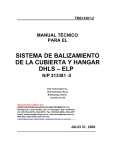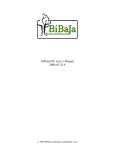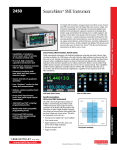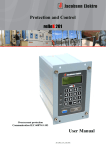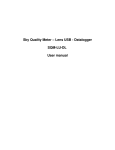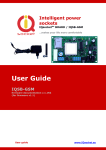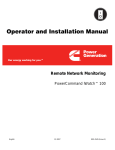Download IVC24-04 User`s Manual Version 1.0
Transcript
IVC24-04 User’s Manual Version 1.0 © 2004 Bibaja Landscape Automation, LLC INTRODUCTION 1 DOCUMENT ORGANIZATION 1 INSTALLATION 2 REQUIRED COMPONENTS FOR A BASIC SYSTEM 24-VOLT AC TRANSFORMER SELECTION CHOOSING THE INSTALLATION LOCATION AND WIRING TOPOLOGY CHOOSING THE RIGHT WIRE DEVICE INSTALLATION WORKSHEET DEVICE WALL MOUNTING VALVE BOX INSTALLATION WIRING THE DEVICE NETWORK CONFIGURATION DEVICE COMMISSIONING NETWORK VARIABLE CONNECTIONS 2 2 3 6 9 11 11 11 12 12 14 IVC24-04 DEVICE SPECIFICATION 20 ELECTRICAL SPECIFICATIONS AND OPERATING CONDITIONS VSUPPLY ISUPPLY VOUT(1,2,3,4) IOUT(COMBINED) IMEASURED IERROR TEMPERATURE ESD DEVICE FEATURES TRIAC OUTPUTS DISCONNECTED OUTPUT DETECTOR CURRENT MEASUREMENT POWER SUPPLY AND POWER LED MICROCONTROLLER WITH EMBEDDED POWER LINE COMMUNICATIONS NETWORK ACTIVITY LEDS MAGNETICALLY ACTIVATED SERVICE PIN 20 20 20 20 20 20 20 21 21 21 21 21 22 27 27 28 28 APPLICATION EXAMPLES 29 LAWN & GARDEN IRRIGATION SYSTEM WITH MASTER VALVE REQUIRED COMPONENTS SYSTEM LAYOUT AND WIRE SELECTION 29 29 31 Bibaja Landscape Automation, LLC i © 2004 SYSTEM SETUP AND OPERATION USING THE IVC24-04 FOR GENERAL 24-VOLT AC DEVICES CONTACTORS RELAYS AIR DUCT DAMPERS DRIVING DC DEVICES USING THE IVC24-04 OUTPUTS AS INPUTS Bibaja Landscape Automation, LLC ii 33 34 34 34 34 35 35 © 2004 INTRODUCTION The IVC24-04 is a four-output device useful for remote control of automatic irrigation valves, relays, contactors, and many other standard 24VAC devices. The versatile triacdriven outputs of the IVC24-04 are well suited for many different applications. Embedded power line communications and a sealed IP65/NEMA4 enclosure provide easy system expansion. No need to dig a trench and lay new wires out into the field. Attach wires to the nearest 24VAC power and add new valves. The IVC24-04 may be placed into the valve box with the valves. Integrated output disconnect detection circuitry provides a way to detect when the outputs have been disconnected. This feature may be used to sense contact closures as well, making the output of the IVC24-04 function as an input. This document will present important details regarding how to install the IVC24-04 device and how to select the proper power supply and wiring. Pay close attention to the specified ratings for the IVC24-04 device. Do not exceed the maximum ratings to guarantee years of reliable operation. Detailed specifications are given for the operation of some of the internal circuitry within the IVC24-04. These circuit details will show you how our device operates and possibly inspire other ideas for applications using the IVC24-04 device. We will also attempt to cover a few application ideas for the IVC24-04. Check our website periodically for new application ideas and updates for the IVC24-04 product. Document Organization This document is organized into three major sections: 1) Installation – Provides a detailed guide for 24VAC transformer selection, wiring topology, and mounting of the IVC24-04. Also gives a brief guide to installing and configuring the IVC24-04 using LonWorks network management tools. 2) Device Specification Specifies the voltage and current ratings for the device. Also provides an indepth overview of device operation. These details may be of interest to people who wish to understand how the circuits operate in more detail. 3) Application Examples – Application ideas for the IVC24-04 device. Bibaja Landscape Automation, LLC 1 ©2004 INSTALLATION Required Components for a Basic System The required components to build a basic system are: • One IVC24-04 for every 4 zone valves • One 24-volt AC transformer for supplying power • One PLC240 to bridge communications across the 24-volt AC transformer • One USB12-01 power line network interface for your computer or other compatible LonWorks powerline interface (Available from www.engenuity.com) • One computer to run the system, log data, and interface with the internet Here is diagram showing an example system and connections: House AC Power 24-volt AC Transformer 24-volt AC Power 24-volt AC Transformer Selection Selecting the right 24-volt AC transformer for your system depends on the system’s maximum current requirement. Consider a lawn & garden irrigation system with 10 zones and 1 master valve. This system will require 3 IVC24-04 units. Two valves will be active at the same time: The master valve and one zone valve. Typical irrigation valves consume less than 300ma steady-state current with a maximum inrush current of 700ma. Valves are actuated sequentially. Therefore only one valve will consume the inrush current, while all other active valves will consume the steady-state current. Each IVC24-04 device consumes a Bibaja Landscape Automation, LLC 2 ©2004 maximum of 100ma. The rating of the transformer will be the sum of these currents calculated as follows: 1 master valve steady-state 1 zone valve inrush 3 IVC24-04 @ 100ma Total = 300ma = 700ma = 300ma = 1300ma required current VA Requirement (V*A) = 24V * 1.3A = 31.2VA minimum 24VAC transformers of various VA ratings are available online. Here is a short list of places online where you can order wall plug and wire lead transformers, sorted by increasing VA ratings: Vendor Website Part # www.digikey.com MT7116-ND www.jameco.com www.jameco.com VA Cost (Estimated) 19.9 $13.05 10102 176356 24 30 $7.95 $10.49 www.smarthome.com 3061 40 $14.99 www.mouser.com P-8663 96 $24.24 www.mouser.com P-8665 192 $37.00 www.jameco.com 221410 288 $41.95 Features Wall plug, screw terminals Wall plug, 3.1mm jack Wall plug, 2.1mm jack Wall plug, screw terminals Transformer, wire leads Transformer, wire leads Transformer, lugs Note wire lead transformers are recommended only for those comfortable dealing with electrical wiring. Wall plug transformers are much more convenient and plug into any available AC outlet. Choosing the Installation Location and Wiring Topology The IVC24-04 enclosure is NEMA4/IP65 rated, so it may be located outdoors or indoors. The choice of installation location will be determined by the choice of wiring topology. For retrofit applications of simple 4-zone irrigation controllers, choosing the location is simple: Put the IVC24-04 in the same location where the old controller was and use the existing wiring. In some cases, the AC transformer from your old controller may work to supply the IVC24-04 power as well. You will also need to bridge the power line communication across the 24VAC transformer using the PLC240 device from Bibaja. Without the PLC240, the USB12-01 will not be able to communicate with the IVC24-04. Bibaja Landscape Automation, LLC 3 ©2004 For larger retrofit applications involving multiple zones all star-wired back to a central location, the existing wiring may be reused to bring 24VAC power to the valve locations and the IVC24-04 units placed outdoors with the valves. Here is an example of a 16zone system before retrofit: Original 16-Zone Controller 1 2 3 4 5 6 7 8 9 10 11 12 13 14 15 16 C COMMON WIRE 1 16 2 15 3 14 4 13 5 12 6 11 7 10 8 9 COMMON WIRE For the retrofit, every two wires would be connected together to bring 24VAC power to each IVC24-04 installed with each of the 4 valve groups like this: Bibaja Landscape Automation, LLC 4 ©2004 NEUTRAL 24 VAC AC LINE PLC240 1 2 3 4 5 6 7 8 9 10 11 12 13 14 15 16 C COMMON WIRE NOT USED 1 16 2 15 IVC24-04 IVC24-04 C 3 C 14 4 13 5 12 6 11 IVC24-04 7 IVC24-04 C C 8 10 9 The original valve control wires now carry 24VAC power and control signals to each IVC24-04. Pairing every two wires insures adequate current and voltage for each IVC2404 and provides a little extra for system expansion. The original common is cut at each valve group so only 4 valves are on each common (indicated by dashed lines in diagram). This new 4-valve common is wired to the IVC24-04 corresponding to the valve group. New controllers may be quickly added in the field by chaining a pair of wires from the closest 24VAC power feed to the new valve group. New installations may choose a star or bus topology for the wiring. For star topology wiring, all of the IVC24-04 devices would be mounted in one location, such as a garage or utility building wall, with output wires pulled out to each valve group. One disadvantage with this topology is the cost of the wire. Having long wires from the IVC24-04 to the valves may cost more than the bus topology. Adding more zones is also Bibaja Landscape Automation, LLC 5 ©2004 difficult with the star topology. New output wires must be routed and buried from the central controller location to the valves resulting in more digging and more labor costs. For bus topology wiring, the IVC24-04 devices may be installed in the field near the valves. One pair of wires carrying 24VAC power would be bussed between each IVC2404. The IVC24-04 would be used to control the nearest 4 valves and could be located inside one of the valve boxes. For example: 24VAC VALVE BOX VALVE BOX VALVE BOX VALVE BOX VALVE BOX VALVE BOX VALVE BOX IVC24-04 VALVE BOX IVC24-04 One advantage of the bus topology is a reduction in wiring costs compared to the star topology. Only two wires go out into the field to each valve group. Another advantage is the ease of adding more devices. Extending your system is as easy as tapping the nearest 24VAC bus wire, connecting an IVC24-04, and adding valves to the nearest water feed pipe. Choosing The Right Wire Choosing the right wire will insure reliable system operation. The right wire will supply sufficient current and voltage for powering remote IVC24-04 devices and valves. To choose the right wire, you will need to be able to answer the following questions: 1) 2) 3) 4) What topology of wiring did you choose, bus or star? What is the longest wire segment carrying 24VAC power? How many devices (IVC24-04 and other) are on the longest wire segment? How many outputs will be active at the same time and what is the maximum current consumption of each output? If the answer to questions 1 is star topology, you don’t really need to answer the remaining questions. For distances less than 100 feet between the 24VAC transformer and the IVC24-04 devices, 18AWG wire should be sufficient. 14AWG wire should be used for current consumption greater than 3 amps or distances greater than 100 feet from Bibaja Landscape Automation, LLC 6 ©2004 the 24VAC transformer to the IVC24-04 devices. Typically 18AWG wire is used to connect from the IVC24-04 to the remote valves. Installers may wish to consider running a spare 14AWG wire pair carrying 24VAC out in the field. This will provide for easier expansion in the future. If the answer to question 1 is bus topology, you must provide estimates for the answers to questions 2-4. Questions 3 and 4 are used to determine the maximum current consumption on the longest wire segment. Consider a situation where you have 4 IVC24-04 devices on a 500ft wire segment. This segment has a pump control relay, a fertigation valve, and zone valves. One and only one zone valve is active at a time. The pump control relay, one zone valve, and the fertigation valve may all be active simultaneously. Find the maximum current consumption numbers for each device attached to the wire segment: IVC24-04 Pump Relay Fertigation Valve Zone Valve 400ma (4 at 100ma each maximum) 4000ma (inrush) 600ma (typical) 700ma (inrush) 300ma (typical) 700ma (inrush) 300ma (typical) Note the inrush current requirement of the pump relay is 4amps (4000ma). The wire must be chosen to guarantee this current spike does not cause the voltage to dip beneath 18V or the pump relay may not activate. The maximum inrush current calculation is the worst device plus the static current drawn by always-on devices like the IVC24-04: Inrush = 100ma * 4 + 4000ma Inrush = 4400ma Since the pump is the first device activated, the current of the fertigation valve and zone valve do not need to be included in the inrush calculation. The typical operating current will be the maximum current for the 4 IVC24-04 devices, the pump relay current, the fertigation valve, and one of the zone valves: Typical = 100ma * 4 + 600ma + 300ma + 300ma Typical = 1600ma Use the larger of the two currents to determine the wire size and the transformer requirement for your system. In this case, choose the inrush current of 4400ma. If you plan to expand your system later, add some excess current to account for future devices as well. Use the following table to determine the wire gauge based on your longest wire segment and the current consumption on that wire: Maximum Current (ma) Longest Wire Segment (feet) <100 <250 <500 <1000 Bibaja Landscape Automation, LLC 7 <1500 ©2004 <500 <750 <1000 <1500 <2000 <2500 <3000 <4000 <5000 <7500 <10000 18AWG 18AWG 18AWG 18AWG 18AWG 18AWG 18AWG 14AWG 14AWG 12AWG 10AWG 18AWG 18AWG 18AWG 14AWG 14AWG 14AWG 12AWG 12AWG 10AWG 8AWG 8AWG 18AWG 14AWG 14AWG 12AWG 12AWG 10AWG 10AWG 8AWG 8AWG 14AWG 12AWG 12AWG 10AWG 8AWG 8AWG 12AWG 10AWG 10AWG 8AWG The criteria for producing this gauge chart was what gauge of wire would produce less than 3.5 volts of drop at the rated current over the distance in feet. For our example of 500ft of wire with a current requirement of 4400ma, we would need 8AWG wire. Note for this example you could eliminate the need for the 8AWG wire by placing the IVC24-04 that controls the current hungry pump relay close to the 24VAC transformer. This removes the pump relay from the longest wire segment and places it on an isolated segment. This is better design practice and may result in wiring cost savings. Placing the pump relay control close to the 24VAC transformer will allow the 500ft wire segment to be reduced to 14AWG wire (<1000ma for 500ft). This topology is basically a combination of the star and bus topology. If your system requires more current, consider running multiple bus power feeds in a star topology back to your 24VAC transformer and divide the current among the different power feeds. Using a combination of star and bus topology wiring may be more economical than using wire larger than 12AWG. Direct burial wire from 18AWG through 12AWG is readily available. Also consider placing high current consumption devices close to the 24VAC supply transformer. Bibaja Landscape Automation, LLC 8 ©2004 Device Installation Worksheet Recording key information while installing the IVC24-04 devices will make the software setup much simpler. To assist with this task, we have provided the device installation worksheet on the following page. Print out copies of this worksheet fore each IVC24-04 device installed and record the device information to make software configuration simpler. These worksheets will also serve as a record for the installer and the system owner for what device outputs control what zones and where the devices are physically located. The worksheet has spaces to record several key pieces of information: • • • IVC24-04 NID (From Barcode) o This is the 12-character unique ID found on the barcode on the side of the IVC24-04 device. This ID is used to communicate with the device through the power line network. Output 1, 2, 3, and 4 o These rows are to record information about what is connected to each output of the IVC24-04 device Connected To o Record what this output is connected to. This information is important for configuring this output as a zone valve control, fertigation valve control, master valve control, contact closure sense input, etc. If the device is attached to a Cutler-Hammer contactor, for example, then record that information as well since the contactor may require more inrush current to actuate properly. The note space should be used to record any other special information about the connections. The IVC24-04 NID barcode is found on a label on the side of the device. The label should look similar to this: *050001020300* ! The NID is all numbers and letters between the two “* *” on the label. The ! symbol is where to touch a magnet for activating the internal service switch to send the unique ID over the network for installation. Bibaja Landscape Automation, LLC 9 ©2004 IVC24-04 Installation Worksheet Job: Install Date: MM/DD/YYYY IVC24-04 NID (from Barcode) Device Location __ __ /__ __ /__ __ __ __ * __ __ __ __ __ __ __ __ __ __ __ __ * Output # Zone Name: Zone # Connected To: 1 2 3 4 Notes: Bibaja Landscape Automation, LLC 10 ©2004 Device Wall Mounting The IVC24-04 provides two screw holes outside of the sealed area for wall mounting. To attach the IVC24-04 to a wall: • • • • • • • • • • • • Turn off power to IVC24-04 (if powered) Loosen the black cable gland nut Push and turn the 4 screw latches ¼ turn to release the lid Carefully slide the lid of the IVC24-04 along the cable out of the way Get a pencil Hold the base of the IVC24-04 against the wall in the desired location and mark the two hole locations with the pencil Set the IVC24-04 aside and pre-drill the screw holes, if necessary Feed screws into the base of the IVC24-04 unit, being careful not to drop the screws onto the exposed electronics Tighten the screws into the holes in the wall just until snug. DO NOT OVER TIGHTEN MOUNTING SCREWS. Over tightening the screws could warp or crack the case, compromising the sealed chamber. Slide the lid back along the cable and onto the base. Push and turn the 4 screw latches ¼ to secure the lid Tighten the black cable gland nut Valve Box Installation The IVC24-04 devices are in sealed NEMA4/IP65 enclosures enabling installation outdoors or in below ground valve boxes. The IVC24-04 may be attached to the underside of the valve box lid following the procedure for device wall mounting. The preferred method is to simply install the valve in the bottom of the valve box as normal, attach the wires to the IVC24-04 using waterproof connections, and lay the IVC24-04 in the valve box resting on top of the valve assembly. The IVC24-04 comes with about 2 feet of cable, so it makes it easy to lift the IVC24-04 out of the way if you need to access the valve or replace the valve solenoid. Wiring the Device Outdoor connections should use water resistant connections such as wire nuts with grease caps. Indoor connections may be made using wire nuts, or by crimping quick disconnect or screw terminal connectors onto the bare wires. The wires of the IVC24-04 are color coded as indicated on the lid of the device: 24VAC POWER OUTPUT 1 OUTPUT 2 LINE NEUTRAL SUPPLY COMMON SUPPLY Bibaja Landscape Automation, LLC BROWN BLUE ORANGE YELLOW 11 ©2004 OUTPUT 3 OUTPUT 4 COMMON SUPPLY COMMON SUPPLY COMMON GRAY VIOLET GREEN RED BLACK Attach the LINE/NEUTRAL connections to the 24VAC power wires. Try to keep the LINE and NEUTRAL connections consistent between devices in the field. Keeping LINE and NEUTRAL consistent throughout the installation will prevent damage in the event that commons from two different IVC24-04 devices become shorted together. Attach the LINE/NEUTRAL connections to the 24VAC power bus wires. Try to keep the LINE and NEUTRAL connections consistent between devices in the field. This will prevent damage in the event that commons from two different IVC24-04 devices become shorted together. Connect the output SUPPLY wires to valves, relays, contactors, or to the anode (positive terminal) of diodes for devices requiring DC power. See the applications guide for more information. The four COMMON wires are common only to the outputs of a specific IVC24-04 device. One common wire may be used for all 4 outputs, or all 4 commons may be attached, one per output. ! Do not connect the commons of different IVC24-04 devices together. This will cause improper operation of the current sensing circuit and possible failure of the device. Once wiring is complete, apply power to the devices and confirm the power LED is illuminated. Network Configuration This section applies to users who are using tools such as Echelon’s LonMaker for Windows and devices like Echelon’s i.Lon100 to configure and control the IVC24-04 devices. Bibaja is working to develop our own configuration and control software based on the USB12-01 device. If you have feedback about features you would like to see in this software, feel free to provide this information by email to [email protected] with the subject “Software Feature Request.” Device Commissioning For this step, either have the IVC24-04 Installation Worksheet handy or have a magnet ready to activate the service pin. Bibaja Landscape Automation, LLC 12 ©2004 Choose to commission or install a new device using your chosen software package (LonMaker for Windows, for example). When you get to the step for identifying the new device, you have the option to either use service pin installation or manual installation. For service pin installation, select “Service Pin” and proceed to the point where you are prompted to press the service pin. Using a magnet, touch it to the + symbol on the side of the device. Make certain the TX LED flashes at least once to confirm the service pin message has been sent. For manual installation, either type or scan the NID from the label from the side of the device. If you used the IVC24-04 Installation Worksheet form, the NID should be recorded on the third line “IVC24-04 NID”. Enter the 12 letters and numbers between the two asterisks “**”. Here is an example dialog from LonMaker for entering the IVC24-04 NID manually: Once the device commissioning and installation process has been completed, you are ready to proceed to making network variable connections and updating the device configuration properties. You may also look for “unconfigured” devices. The IVC24-04 device ship uncofigured from the factory and may be installed this way if your installation tool supports it. Bibaja Landscape Automation, LLC 13 ©2004 Network Variable Connections One the device has been commissioned, the network variables may be bound to controllers such as the i.Lon100. The available network variable inputs (nvi’s), network configuration inputs (nci’s), and network variable outputs (nvo’s) for controlling and monitoring the device are: IVC24-04 nvi nviOut1 nvoState1 nvo nvi nviOut2 nvoState2 nvo nvi nviOut3 nvoState3 nvo nvi nviOut4 nvoState4 nvo nvoDisconnect1 nvo nvoDisconnect2 nvo nvoDisconnect3 nvo nvoDisconnect4 nvo nvoOverCurrent1 nvo nvoOverCurrent2 nvo nvoOverCurrent3 nvo nvoOverCurrent4 nvo nvoCurrentRaw nvo nvoCurrentMil nvo nvoACFreq nvo nci nciMaxRcvTime NV/NC Name Type nviOut1 SNVT_switch nviOut2 SNVT_switch nviOut3 SNVT_switch nviOut4 SNVT_switch Bibaja Landscape Automation, LLC Default Value state = off value = 0.0 state = off value = 0.0 state = off value = 0.0 state = off 14 Description Controls output OUT 1 Controls output OUT 2 Controls output OUT 3 Controls output OUT 4 ©2004 nciMaxRcvTime SCPTmaxRcvTi me value = 0.0 60.0 seconds Output automatic shutoff timer. If no update is received on nviOut1 through nviOut4 within the configured time nciMaxRcvTime, the outputs will be shutoff. nvoState1 SNVT_switch nvoState2 SNVT_switch nvoState3 SNVT_switch nvoState4 SNVT_switch nvoDisconnect1 SNVT_switch state = off value = 0.0 state = off value = 0.0 state = off value = 0.0 state = off value = 0.0 depends on connection This helps to prevent flooding in case of controller failure. Feedback for the state of output OUT 1 Feedback for the state of output OUT 2 Feedback for the state of output OUT 3 Feedback for the state of output OUT 4 Feedback to monitor output connection for OUT 1. May also be used as a contact closure input sensor. Set to state = off, value = 0.0 when output is connected. (When contact is closed) nvoDisconnect2 SNVT_switch depends on connection Set to state = on, value = 100.0 when output is disconnected. (When contact is open) Feedback to monitor output connection for OUT 2. May also be used as a contact closure input sensor. Set to state = off, value = 0.0 when output is connected. (When contact is closed) Set to state = on, value = Bibaja Landscape Automation, LLC 15 ©2004 nvoDisconnect3 SNVT_switch depends on connection 100.0 when output is disconnected. (When contact is open) Feedback to monitor output connection for OUT 3. May also be used as a contact closure input sensor. Set to state = off, value = 0.0 when output is connected. (When contact is closed) nvoDisconnect4 SNVT_switch depends on connection Set to state = on, value = 100.0 when output is disconnected. (When contact is open) Feedback to monitor output connection for OUT 4. May also be used as a contact closure input sensor. Set to state = off, value = 0.0 when output is connected. (When contact is closed) nvoOverCurrent1 nvoOverCurrent2 SNVT_switch SNVT_switch Bibaja Landscape Automation, LLC state = off value = 0.0 state = off value = 0.0 16 Set to state = on, value = 100.0 when output is disconnected. (When contact is open) Set to state = on, value = 100.0 when OUT 1 was the last output activated before an over current event was detected. State be cleared by correcting the problem and reactivating the output or by resetting the device. Set to state = on, value = 100.0 when OUT 2 was the last output activated before an over current event was detected. ©2004 nvoOverCurrent3 nvoOverCurrent4 nvoCurrentRaw nvoCurrentMil nvoACFreq SNVT_switch SNVT_switch SNVT_count SNVT_amp_mil SNVT_freq_hz Bibaja Landscape Automation, LLC state = off value = 0.0 state = off value = 0.0 State be cleared by correcting the problem and reactivating the output or by resetting the device. Set to state = on, value = 100.0 when OUT 3 was the last output activated before an over current event was detected. State be cleared by correcting the problem and reactivating the output or by resetting the device. Set to state = on, value = 100.0 when OUT 4 was the last output activated before an over current event was detected. State be cleared by correcting the problem and reactivating the output or by resetting the device. Raw count output from the current sensor. See the device specification section for more information about using this output. 0 Output is updated once per second when non-zero. RMS current in milliamps converted from raw current using a 5-segment piecewise linear fit. 0 Output is updated once per second when non-zero. Depends on Output from the line line frequency frequency detector for status. Reports either 50.0 or 60.0Hz. 17 ©2004 nviOut1 – nviOut4 Connect nviOut1 through nviOut4 to the controller to turn outputs 1 through 4 on and off. ! Do not bind nviOut[1-4] if the corresponding output[1-4] is used as an input to sense a contact closure. This may result in an over current event and possibly damage the contacts of the attached sensor. nciMaxRcvTime By default, nciMaxRcvTime is set to 60 seconds. This configuration parameter sets the timeout from the automatic shutoff timer. When one of the network variable inputs nviOut1-nviOut4 is updated, the timer will be initialized to this value and begin counting down. When the timer reaches 0, the output will be turned off. If the network variable input is updated before the timeout, the output will remain active. This shutoff timer helps to prevent flooding in the event that the computer or controller responsible for turning the output off fails. You may choose this timeout value based on the maximum run time for the 4 attached zones or based on the amount of traffic on your power line network. If your controller is fairly simple and does not support “heartbeat” updates of network variables, then the timeout value should be configured to the maximum run time of the attached irrigation zones or devices. nvoState1 - nvoState4 These four network variable outputs indicate the state of the device outputs 1-4. In a polled system, these outputs may be monitored to determine if the output properly activated. These network variable outputs do not reflect the state of the corresponding network input nviOut1-nviOut4. Instead they reflect the actual output status. After activating an output using one of nviOut1-nviOut4, you must wait at least 10 AC Cycles to guarantee the corresponding nvoState1-nvoState4 feedback has set. The maximum wait time is 200ms. These status outputs may be bound to a datalogger or to lights on a status panel to provide system status. nvoDisconnect1-nvoDisconnect4 These four network variable outputs indicate whether an output has been disconnected. If the output is disconnected, the network variable output will assume the state “on” and value=100%. Connected outputs will assume the state “off” and value=”0%”. These nvo’s may be used to sense contact closures if the outputs are used as inputs. When the contact attached to an output is closed, the corresponding nvo will assume the “off” state. Bibaja Landscape Automation, LLC 18 ©2004 When the corresponding network variable input nviOut1-4 is set to “on” and a non-zero value, nvoDisconnect1-4 will assume the “off” and “0%” setting. nvoOverCurrent1-nvoOverCurrent4 These four network variable outputs indicate which output caused the last over current event. Over current events happen when the combined current draw of all outputs exceeds about 1.3amps for 6 AC cycles in a row. The IVC24-04 is capable of providing brief inrush currents of up to about 10amps to start devices like contactors. These outputs latch state and may be reset in any of the following ways: • Reset the IVC24-04 device (clears all status) • Correct the problem and reactivate the output • Cause an over current event on another output If the combined current of all active outputs is greater than 1.2amps, consider moving some active outputs to another IVC24-04. If the current drawn from a single output exceeds 1.2amps, then it is recommend that an intermediate relay be used to drive the external load. Relatively low cost relays are available from Digikey (www.digikey.com) with 24VAC coils that consume around 130ma of current. nvoCurrentMil and nvoCurrentRaw Most users interested in datalogging the current will use network variable output nvoCurrentMil. This output reflects the combined current consumption of all outputs in milliamps from 340.0ma up through 3276.7ma. The accuracy of the current measurement is +/- 6%. Current below 340.0ma will not register and will be reported as 0.0ma. This sensor should be monitored to detect increasing current consumption over time. Increasing current consumption may be an indicator that a valve solenoid or other attached device is failing. When the current consumption is non-zero and greater than 340ma, this output will be updated at most once per second. With a large network of these devices, therefore, you will quickly exceed the channel capacity if these connections are bound. Instead of binding, it is recommended to periodically poll nvoCurrentMil on all devices with active outputs. For instructions on using nvoCurrentRaw, see the device specification in this manual. nvoACFreq This network variable output indicates the line frequency. It is updated when the device is reset. The line frequency reported will be either 50Hz or 60Hz. If the line frequency is 100Hz, for some reason, it will therefore report 60Hz. 40Hz will report as 50Hz. This output is not an indicator of the precise line frequency. Bibaja Landscape Automation, LLC 19 ©2004 IVC24-04 DEVICE SPECIFICATION Electrical Specifications and Operating Conditions Parameter Vsupply Isupply Vout(1,2,3,4) Min 18 --93% of Vsupply Iout (combined) --Imeasured 354 Ierror -6 Temperature -25 ESD --- Typ 24 70 --- Max 28 100 --- Units VAC (RMS) ma (RMS) VAC (RMS) 300 ----25 --- 1200 1300 +6 70 15 ma (RMS) ma (RMS) % error C kV Vsupply Vsupply is the supply voltage applied to the 24VAC power supply input. Note the outputs require AC supply voltage for proper operation. Isupply Isupply is the current drawn, in milliamps RMS, from the 24VAC power supply input. Vout(1,2,3,4) Vout(1,2,3,4) is the output voltage when output 1, 2, 3, or 4 is activated. The figure 93% of Vsupply assumes the supply has at least 1.3amps of current available. Iout(combined) Iout(combined) is the maximum output current allowed on all 4 outputs combined. If this current limit is exceeded for more than 6 AC cycles in a row, all outputs will be turned off and the last output turned on will be flagged as the one that caused the over current condition. Imeasured Imeasured is the range of the current measurement circuit. Currents below 354 milliamps RMS do not cross the voltage reference used to perform the current measurement. Above 1300 milliamps RMS, the over current detector will turn all outputs off. Ierror Ierror is the range of error for the piecewise linear fit used to calculate the network variable output nvoCurrentMil. It is possible to achieve higher accuracy by trimming the piecewise linear model or by using the network variable output nvoCurrentRaw to create your own best-fit model for the current. See the “Current Measurement” section for more information. Bibaja Landscape Automation, LLC 20 ©2004 Temperature Temperature is the operating temperature range of the device. The device will function to 85C if you use only 1 output at a time and limit the load current to less than 600ma. ESD ESD is the electrostatic discharge limit to which the devices were tested during development. At 15 kilovolts, the device showed no failures or resets. Device Features Triac Outputs There are four triac driven outputs on the IVC24-04. Using triacs for output switches reduces the current consumption and simplifies the power supply design. The triacs are optically isolated from the microcontroller for protection from external electrical disturbances. Each of the 4 output circuits looks like the following diagram: 24VAC Line Digital Out Opto Out(1,2,3, or 4) Common Isense 0.5 ohm Neutral Note the 0.5ohm current sense resistor is shared between all 4 output circuits. The 4 common wires are provided for wiring convenience. Connecting commons between different IVC24 devices will cause improper operation of the current sense circuit. See the section “Current Measurement” for more details. Disconnected Output Detector The disconnected output detector relies on leakage in the output triac to determine when an output has been disconnected. Relay coils, irrigation valve solenoids, and other typical loads have a resistance much less than 1k ohms. This load will provide a path for the leakage current back to Neutral. The path to Neutral is broken when the load is disconnected. This disconnect is then easily detected by providing an alternate path with a much higher resistance. Bibaja Landscape Automation, LLC 21 ©2004 The following circuit diagram shows the disconnect detect sense resistor connected to the output: 24VAC Line Digital Out Opto Disconnect Detect Out(1,2,3, or 4) Common Isense 0.5 ohm Neutral When the output is disconnected, a square wave (due to clamp diodes in the digital input of the microcontroller) is present on the digital logic side of the disconnect detect sense resistor. The microcontroller watches for this toggling input. If the input toggles for more than 6 cycles in a row, the output will be marked as disconnected. At 50Hz, therefore, it will take 6 AC line cycles, or 6 * 20ms = 120ms to detect a disconnected output. When driving a DC load (by adding a single diode, for example), connect the diode as shown below for proper operation of the disconnected output detector: 24VAC Line Digital Out Opto Disconnect Detect Out LOAD Common Isense 0.5 ohm Neutral Connecting the diode with this orientation drives the load using the positive half cycle. This allows the load to sink the leakage current on the positive half cycle, which allows the disconnect detect circuit to sense the output is connected. Current Measurement Current measurement is accomplished by comparing the voltage across a sense resistor to a reference voltage and then measuring the time the sense resistor voltage is above the reference voltage. Bibaja Landscape Automation, LLC 22 ©2004 The circuit below shows the connection of the current measurement comparator to create the Imeasure signal: 24VAC Line Digital Out Opto Disconnect Detect Imeasure + Out(1,2,3, or 4) Isense Vref Common 0.5 ohm Neutral The output Imeasure will only trigger when the signal Isense is larger than the voltage reference Vref. Vref is set to approximately 0.25 volts with some hysteresis to reject noise. This means the minimum trip current will be: I=V/R (Ohm’s Law) I = 0.25 V / 0.5 ohm (Plug in Vref and current sensor resistor values) I = 0.5 amps (Minimum peak trip current) I = 0.5 / sqrt(2) (Divide by sqrt(2) to find RMS current) I =~ 0.354 amps RMS (Minimum RMS trip current) At around 354 milliamps, therefore, the current sensor will begin to measure current. The Imeasure pulse from the comparator will be relatively short and will resemble the following graph: Bibaja Landscape Automation, LLC 23 ©2004 Imeasure for 1 AC Cycle Current (amps) 0.6 0.4 0.2 Current Imeasure 0 -0.2 -0.4 0. 00 0 0. 00 3 0. 00 5 0. 00 8 0. 01 0 0. 01 3 0. 01 5 0. 01 7 0. 02 0 -0.6 Time (seconds) Imeasure is an active low digital signal shown in yellow and is scaled & overlaid on top of the current waveform. The peak of the current is around 0.5amps and is just enough to trip the comparator. Note the current sensor does not operate in the negative half cycle of the AC waveform. Outputs are activated at the beginning of a positive AC half cycle. This guarantees the minimum time between output activation and over current detection. At 1.3amps RMS, the Imeasure pulse will almost cover the entire positive half cycle as shown in the following graph: Bibaja Landscape Automation, LLC 24 ©2004 2.5 2 1.5 1 0.5 0 -0.5 -1 -1.5 -2 -2.5 Current Imeasure 0. 00 0 0. 00 3 0. 00 5 0. 00 8 0. 01 0 0. 01 3 0. 01 5 0. 01 7 0. 02 0 Current (amps) Imeasure for 1 AC Cycle Time (seconds) Two network variable outputs are provided from the current measurement circuit. The first, named “nvoCurrentRaw”, is type SNVT_count and is the duration in 400ns ticks that the signal Imeasure was low. For example, if the value of nvoCurrentRaw is 6500, the duration of the Imeasure pulse was: Duration = nvoCurrentRaw * 400ns Duration = 6500 * 400 ns Duration = 2600000 ns = 2.6 ms Using nvoCurrentRaw, a function may be derived that more accurately converts the Imeasure time duration into an RMS current value. The second current measurement network variable output, named “nvoCurrentMil”, is type SNVT_amp_mil. “nvoCurrentMil” uses a piecewise linear function to convert the Imeasure pulse time into RMS current in milliamps. The following graph shows the measured current vs. the piecewise linear current for an IVC24-04 unit across the current measurement range: Bibaja Landscape Automation, LLC 25 ©2004 Measured Current vs. Piecewise Linear Fit 1.4 1.2 Current (amps) 1 0.8 DMM Current nvoCurrentMil 0.6 0.4 0.2 0 0 5000 10000 15000 20000 nvoCurrentRaw (400ns counts) The X-axis is the raw network variable output “nvoCurrentRaw”. The blue line is the current as measured by a DMM. The yellow line is the network variable output “nvoCurrentMil”. The current measurement circuit serves two purposes: 1) To detect the over current condition and shut off outputs 2) To monitor increases in current consumption over time The first function helps protect the IVC24-04 and the irrigation network in the event that an output becomes shorted. When the current exceeds the limit for 6 AC cycles in a row on one or a combination of outputs, all outputs will be turned off. The network variable outputs “nvoOverCurrent1” through “nvoOverCurrent4” will indicate the last output activated before the over-current condition was detected. When designing your system, remember to take into account the number of outputs that will be activated simultaneously and the current consumption of those outputs. The total current consumption of all active outputs should not exceed 1.2amps for continuous operation. The second function allows tracking trends in current consumption over time in valve solenoids. Sometimes the current consumption of a solenoid will increase before failing. Monitoring the current consumption of a solenoid while it is activated may give an early warning allowing a solenoid to be replaced before it fails. Bibaja Landscape Automation, LLC 26 ©2004 Power Supply and Power LED The power supply requires AC power, 50 or 60Hz, from 18 up to 28Vrms. Typical input voltage is 24Vrms. The power supply is non-isolated, fuse protected, and has an MOV for protection from voltage spikes and other momentary transients on the 24V power line. It is a good idea to wire Line and Neutral consistently throughout the network, just in case accidental connections are made between different IVC24-04 devices. The Power LED is connected to the first DC stage of the power supply. This stage varies from 25 to 40 volts DC proportional to input power. Brief high current drain, such as packet transmissions, will cause fluctuations in the Power LED brightness. Microcontroller With Embedded Power Line Communications The microcontroller with embedded power line communications that makes this device possible is the Echelon PL3120-E4T10. This 10MHz microcontroller packs 3 processors and a powerful DSP based power line transceiver into a tiny 38-pin TSSOP package. Communication on the power line network is two way, request and acknowledge. This two way acknowledged communication provides much more robust communication compared with X10. Sure, X10 has two way communication, but X10 still lacks robust forward error correction, an alternate carrier frequency in case the primary one is blocked, and the ability to perform remote diagnostics, remote application upgrades, and the ability to transfer a variety of rich data types. The PL3120-E4T10 microcontroller communicates using two carrier frequencies. The primary carrier frequency is approximately 132kHz. The secondary is approximately 115kHz. The secondary frequency is only used if the first two attempts on the primary carrier are not acknowledged. Remote diagnostics are possible with the microcontroller. Application firmware keeps statistics for number of packets received, CRC errors, missed messages, last error logged, last cause of reset, and other useful information for remote diagnosis of problems. The application firmware is stored in electrically erasable programmable memory, or EEPROM for short. This memory may be rewritten 10,000 times. New application firmware may be downloaded into the unit without removing it from the field. New features, customer requested features, and bug fixes are all possible using this remote upgrade capability. Rich data types are available above and beyond simple on/off/dim controls. Soil moisture, date & time, wind speed and direction, current consumption, and water flow rate are all examples of data that may be transferred across the network and logged in the central controller. The IVC24-04 uses these flexible data types to provide feedback for Bibaja Landscape Automation, LLC 27 ©2004 output state, output disconnect, output over current, current consumption, and AC line frequency. See Bibaja’s IOPoint product line if you would like to learn how you may easily embed this powerful microcontroller in your own application. Network Activity LEDs The network activity LEDs TX and RX indicate when a packet is transmitted by this device (TX) or received by this device (RX). Magnetically Activated Service Pin The magnetically activated service pin is used to transmit the unique ID, called the Neuron ID (NID for short), for installation. On one side of the IVC24-04 you will see a label with a barcode and a lightning bolt symbol like this: *050001020300* ! Touch a magnet to the ! symbol on the label to activate the service pin and transmit the NID. A magnetic reed switch inside the IVC24-04 will trigger the microcontroller to send the NID across the power line network. Watch the TX LED to determine when the NID has been sent. If you are having difficulties activating the service pin, you may wish to try a stronger magnet. The number on the barcode between the ** is the NID. In the example label, the NID is “05 00 01 02 03 00”. The unique NID on the barcode is always 12 numbers and letters in the range 0 to 9 and from A to F. As an alternative to using the service pin for installation, this number may be typed or scanned into the computer to install the IVC2404. In the installation section of this document, we recommend that you record this number in the worksheet along with output connection information for each device as you install them. Having this worksheet filled out will simplify software configuration and irrigation scheduling. Bibaja Landscape Automation, LLC 28 ©2004 APPLICATION EXAMPLES This section gives several application examples utilizing the IVC24-04. If you have an application idea you would like to submit, send an email documenting your application idea to [email protected]. We will periodically publish new applications on our website. Lawn & Garden Irrigation System with Master Valve Using Bibaja’s basic system components, it is possible to build a simple lawn & garden irrigation system with the following features: • • One master valve to shut off all water 11 irrigation zone valves This application example with go step by step through the process of designing the system for a home such as this one: Layout and choice of sprinklers and drip emitters are beyond the scope of this example. Work with a professional licensed irrigation contractor to design your system. Specify Bibaja irrigation controls in advance so your contractor can plan the wiring and layout. Required Components The following components are required to build this system: • Three (3) IVC24-04 devices • One (1) PLC240 device • One (1) USB12-01 device Bibaja Landscape Automation, LLC 29 ©2004 • • • One (1) Computer 24-volt AC transformer Wire for 24-volt AC power bus The devices are connected together like this: House AC Power 24-volt AC Transformer 24-volt AC Power The computer communicates with the network through Bibaja’s USB12-01 power line network interface. For this system, the computer is always on and runs a scheduler program to trigger zones in the irrigation system. The computer may also provide remote access to your irrigation system. Email, paging or other notifications may be enabled based on status feedback from the IVC24-04 devices to alert you to problems. The sooner you know something has gone wrong, the sooner the problem may be repaired saving your investment in landscape plants. From the USB12-01, communication signals travel through the house AC power to the PLC240. The 24-volt AC transformer will block power line communications. The PLC240 is necessary to bridge communications across the 24-volt AC transformer from the house AC power to the 24-volt AC irrigation power. From the PLC240, power line communications travel to the IVC24-04 devices attached to the 24-volt AC power. The computer may turn outputs on and off and check device status to confirm everything is operating properly. Bibaja Landscape Automation, LLC 30 ©2004 System Layout and Wire Selection For this example system, the contractor has decided the front yard requires 3 zones, the back yard and sides require 4 zones, and the garden & orchard areas requires 4 zones. One master valve will be installed to handle all zones. The valves will be placed in 3 groups. One group will be placed behind the shrubbery in the front of the home, another group in the back yard shrubbery, and the garden & orchard valves will be placed in valve boxes near where the zones are needed. Choose Wiring Topology First we need to choose the wiring topology and installation location. The following picture shows where the contractor chose to place the 3 valve groups: ORCHARD/GARDEN ZONES BACKYARD/SIDE ZONES FRONT YARD ZONES MASTER VALVE Bibaja Landscape Automation, LLC 31 ©2004 Based on the contractor’s choices for valve locations, the simplest topology will be bus topology for the wire. Bury the wire along the water main line for the irrigation system. The water main line is the thick black line connecting the checker-patterned valve location markers. One IVC24-04 device will be located at each valve group. The total distance for the 24VAC bus wire will be around 150 feet. The 24VAC transformer and the PLC240 will be installed inside the garage on the wall near the first valve group. If you live in a colder climate, the irrigation contractor may choose to install a manual shutoff valve and a port for connecting a compressor to blow out the water for winterizing your system. Selecting the Wire The wire for the 24-volt AC power should be selected according to the section “Choosing The Right Wire”. There are 4 questions to be answered: 1) 2) 3) 4) What topology of wiring did you choose, bus or star? What is the longest wire segment carrying 24VAC power? How many devices (IVC24-04 and other) are on the longest wire segment? How many outputs will be active at the same time and what is the maximum current consumption of each output? For this system, the wiring topology is bus topology. The longest wire segment is about 150 feet. There are 3 IVC24-04 devices on the longest wire segment. Finally, for question 4, there are two outputs active at the same time: master valve and zone valve. The maximum current consumption will be the steady state current for the master valve and the inrush for one of the zone valves plus the current consumption of the 3 IVC24-04 units: Master Valve Zone Valve 3 IVC24-04 Devices Total 300ma 700ma 300ma 1300ma Maximum Steady-state Current Inrush Current Maximum Steady-state Current Maximum required current From the chart in the installation section, the example system falls in the column <250ft and the row <1500ma making the wire selection 14AWG wire. Installing the system Now you have defined: • The location for the 24VAC transformer and PLC240 (In the Garage) • The location for the IVC24-04s (At each valve group) • The wiring topology (Bus topology, 150 feet) • The type of wire (14AWG, direct burial) The irrigation contractor may now proceed with the installation. Make certain all outdoor connections are water resistant. Bibaja Landscape Automation, LLC 32 ©2004 Make certain to use the worksheet to record the NIDs of each device and the attached zone. This will make software setup much simpler. System Setup and Operation The software to run the system must now be configured. There are three basic tasks to be completed: 1) Install and configure the IVC24-04 devices 2) Define the irrigation system and zones for the software 3) Define the irrigation schedules Install and Configure IVC24-04 Devices Depending on your software, you should have a way to easily add new devices. Refer to your software manual on how to install a new device. You will need the NID from the worksheets to communicate with and install the IVC24-04 devices. Once the IVC24-04 devices are installed, either use the IVC24-04 device plug-in or a device browser to configure the configuration property nciMaxRcvTime for your system. This variable sets the automatic shutoff timers. If the computer loses communication with the IVC24-04, this shutoff timer will turn off the outputs. For simplicity, simply choose the maximum run time for the attached zones. If you have a drip zone that needs to run for 30 minutes, then set the value for nciMaxRcvTime to 1800. Define the Irrigation System and Zones The example irrigation system consists of the master valve and the zone valves. The controller for the system needs to know where the master valve and zone valves are attached to be able to run the system properly. If you are using software such as LonMaker for Windows, you will have to bind the controller you use to guarantee the master valve is activated first, then the zone valves are activated in sequence, and then the master valve is turned off. Heartbeats or multiple updates must be configured to keep the master valve open for the duration of the irrigation cycle. From the worksheets, find which IVC24-04 outputs are connected to what devices in the network. Bind the master valve to the control output that will activate for the duration of each irrigation cycle. Then bind each zone valve to an output on your controller. Define the Schedules Once the connections are established, schedules must be defined to open the valves regularly to meet the landscape’s water requirements. Make certain you know how many minutes each zone requires. The irrigation contractor should be able to tell you how long to run each zone in the system. The sequence to run the system may look like the following: Bibaja Landscape Automation, LLC 33 ©2004 Start at 3:00am, Tuesday and Friday Activate Master Valve Activate Zone 1, 20 minutes Activate Zone 2, 15 minutes Activate Zone 5, 20 minutes Activate Zone 6, 30 minutes Deactivate Master Valve Finish at 4:25am Other sequences of zones may run on different days or may be programmed to run every other day. Using the IVC24-04 For General 24-volt AC Devices The outputs of the IVC24-04 are useful for a variety of different devices other than automatic irrigation valves. This application note will give a variety of different devices and manufacturers and suggest some possible uses for them. Contactors Contactors are typically used to control large AC loads and devices with significantly higher voltages. Large three phase pumps and roof-top air handler units are examples of devices that may be controlled using a contactor. The IVC24-04 may be used to control devices up to 1.2amps. Check the ratings on the 24VAC coil of the contactor you choose to see how much current it draws. It is possible to control up to two Cutler Hammer 40amp contactors, for example. Relays Relays, like contactors, may be used to drive larger AC loads and higher voltages. Typical uses for relays attached to an IVC24-04 are: • • • • • 120VAC landscape lighting control Irrigation pump control 12V low voltage lighting control Greenhouse ventilation fan control Heating cable controls Potter & Brumfield makes a very economical panel mount double pole/double throw relay with a contact rating of 30amps. The part number is T92S11A22-24 and is available from www.digikey.com. Air Duct Dampers Air duct dampers, or air valves, may be used to turn off the conditioned air to a room in your home that isn’t in use. Using the IVC24-04, you can save money by turning off the air to unoccupied or unused rooms. This provides more heat or air conditioning to the rooms that need it. Bibaja Landscape Automation, LLC 34 ©2004 These 24-volt activated dampers are part number 3080 available from SmartHome: http://www.smarthome.com/3080.html Driving DC Devices Certain devices may require direct current or DC. Driving these devices is as simple as adding a diode in series with the output terminal of the IVC24-04. This will provide halfwave rectified DC voltage for driving a motor or other device attached to the output. By attaching a full-wave bridge rectifier to the output, more energy may be applied to the DC load. Attach the output and common to the ~ inputs of the bridge. Attach the +/outputs from the bridge to your device. Measure the output voltage from the rectifier to be sure it is within the ratings of the device you are trying to drive. Using the IVC24-04 Outputs as Inputs It is possible to use the IVC24-04 disconnected output detector to turn the IVC24-04 outputs into inputs. Certain device types with cold-contact outputs may be attached to the IVC24-04 outputs. When the contacts are closed, the IVC24-04 will think that an output is attached. The corresponding network variable output nvoDisconnect[1-4] will then change to the state “off” with value = 0. When the contacts are open, the nvoDisconnect[1-4] network variable will change to state “on” with value = 1. The following are a few examples of device types that may be attached: • • • PIR Motion Detectors (example: Slimline PIR Detector from www.smarthome.com) Float Switches (example: LVK-10 switch from www.omega.com) Trip wires to detect when someone walked through an area (when wire breaks) Note: Do not activate an output that has one of these devices attached. The IVC24-04 will detect the over current condition after 6 AC cycles and automatically turn off. However, it may do damage to the attached device. Bibaja Landscape Automation, LLC 35 ©2004







































